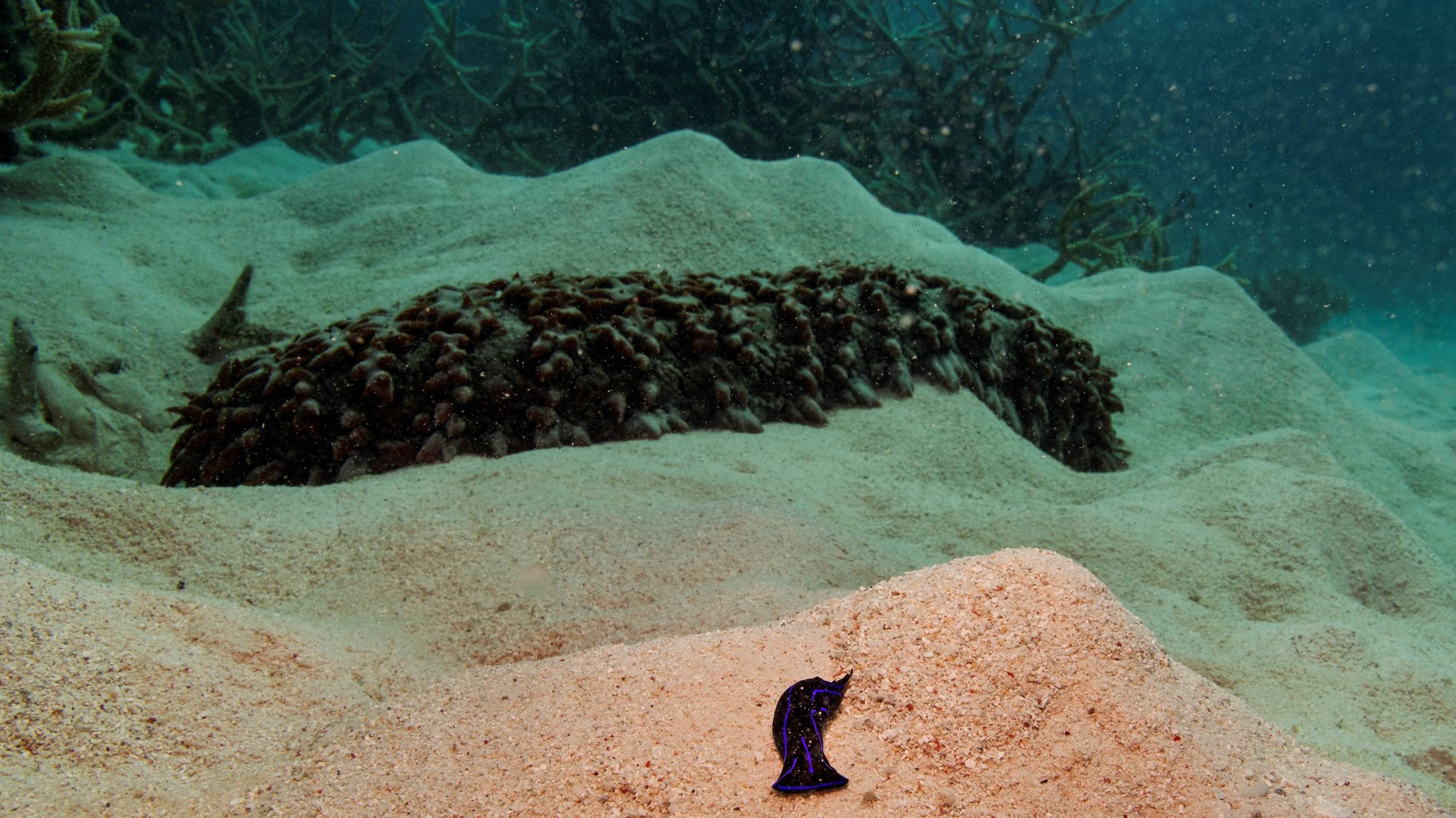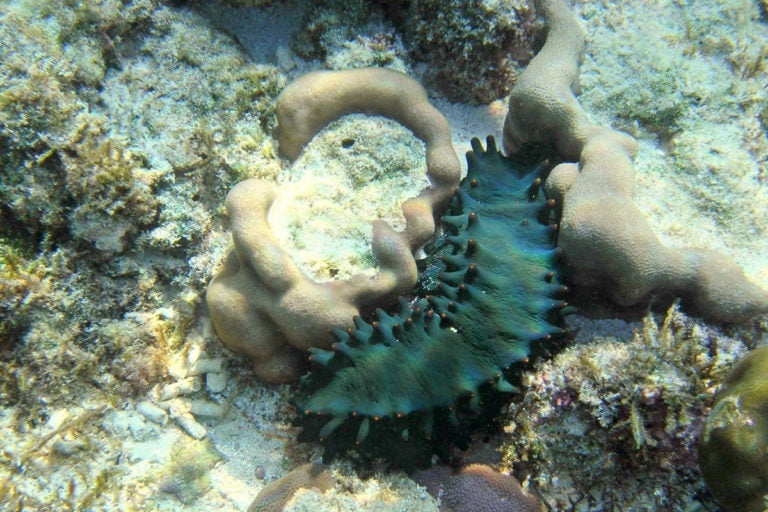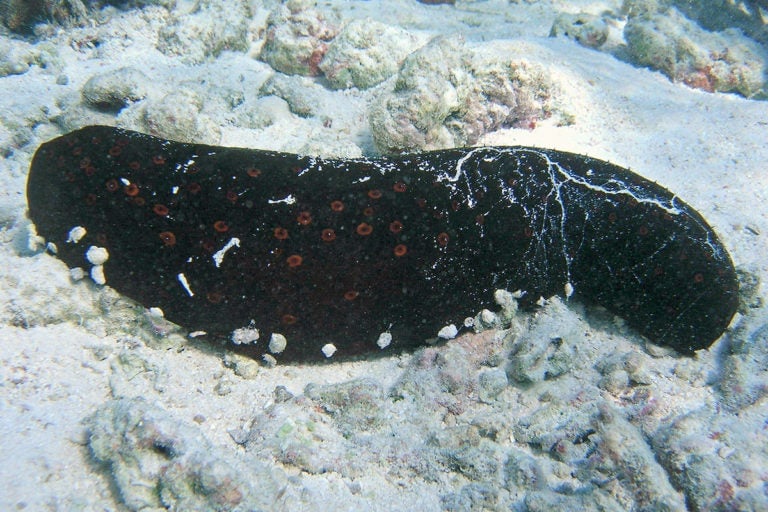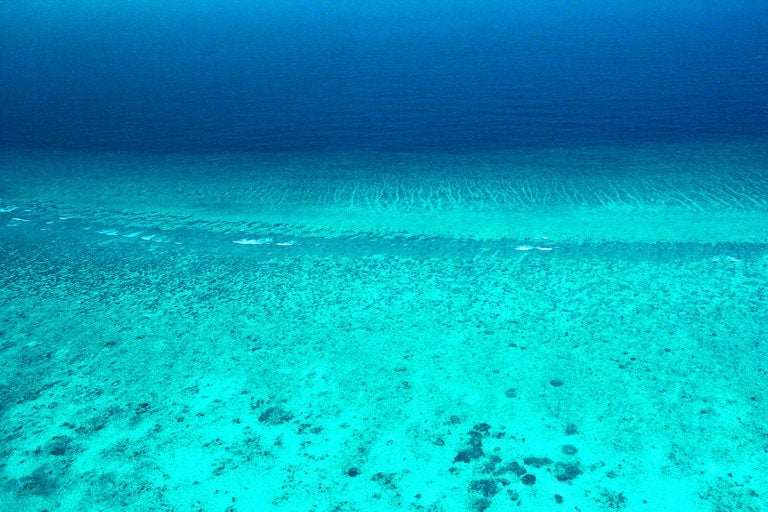India readies the world’s first safe zone for sea cucumbers
Hardly three months have gone by since a special protection force assigned by the administration of union territory of Lakshadweep seized 1,716 sea cucumbers from an uninhabited island named Suhali.


Hardly three months have gone by since a special protection force assigned by the administration of union territory of Lakshadweep seized 1,716 sea cucumbers from an uninhabited island named Suhali.
Weighing 882 kgs and priced at Rs4.26 crore ($562,376) in the international market, the shipment was kept ready for smuggling to Sri Lanka. According to marine biologists, the seizure was the largest ever of its kind in the entire world.
It was a tip-off from the local fish workers that helped the task force to reach Suhali in time on Feb. 12, to seize the shipment hidden in an unseen corner of the coral reefs. The solitary island is located about 60 km away in the sea from Kavaratti, the capital of the cluster of islands.
Though no one has been arrested so far, the New Delhi headquarters of Central Bureau of Investigation (CBI) has taken over the investigation since the third week of March, keeping in view the gravity of the issue and based on recommendations of Wildlife Crime Control Bureau of India (WCCB).
According to Jafer Hisham, marine researcher and a member of the Lakshadweep Biodiversity Council, sea cucumbers are named so because of their resemblance to the vegetable. Generally found on the seafloor, they possess leathery skin and an elongated body containing a single-branched gonad.
An endangered species often vulnerable to poaching, sea cucumbers have been the target of seafood mafia operating in the Indian Ocean region. The illegal transnational trade has been occurring in the Lakshadweep region, despite the WCCB launching enhanced special vigil involving the coastguard, police, forest officials, and fish workers in all the islands, especially in those which remain uninhabited like Suhali.

Smuggling of a protected species
On Jan. 15, the special protection force involving police and forest officials of the island administration had seized 172 sea cucumbers weighing 234 kg and worth Rs1.17 crore from an unnamed island located about 80 nautical miles off Kavaratti. Four persons forming part of an international marine animal trafficking syndicate were arrested.
On Jan. 23, the same force had arrested an international wildlife trade kingpin and seized a consignment of 52 dead sea cucumbers weighing 10 kg and worth Rs5 lakh from him.
Speaking to Mongabay-India over the phone, Lakshadweep’s chief wildlife warden Damodhar AT, who is also the secretary for environment and forests, said the highly sensitive coral reefs of the island cluster are under constant threat due to this continuing illegal trade.
“Sea cucumbers are invertebrates that can grow to up to six feet in length. They are in high demand in China and some parts of southeast Asia for food and traditional medicine. However, India is treating it as a species listed under schedule I of Wildlife Protection Act of 1972. A total ban on their harvesting and transportation in any form has existed in India since 2001,” pointed out Damodhar.
As per Schedule I of Wildlife Protection Act (WPA), sea cucumbers of marine environments enjoy the same status as tigers and lions. The WPA passed in 1972 by the Indian parliament aims at the protection of plants and animal species. The WPA has six schedules of protected plant and animal species. The schedules give varying degrees of protection. Schedule 1 stands for absolute protection and offences under it will invite the highest penalties.
“As per the information we gathered, Sri Lanka is the hub of the illegal trade of these animals to Southeast Asian countries and China. Most people may not like their taste but the Chinese often mix it with other seafood, meat, and spices. In certain parts of Southeast Asia, communities eat them raw, fried or pickled, and also along with Chinese cabbage, winter melon, and shiitake mushrooms. People in Kerala used to eat them in dried form. They had also used sea cucumbers as ingredients of soups, stews, and stir-fries,” explained Hisham.
Going by traditional Chinese medicine, consumption of sea cucumbers can heal a number of ailments, including frequent urination, impotence, arthritis, and cancer. Sea cucumber extracts have also been used widely in China for making creams, tinctures, oils, and cosmetics.
After catching sea cucumbers from the sea around Lakshadweep, smugglers ship them to Sri Lanka as a frozen item. The huge demand and higher price sea cucumbers fetch in the international market is the main reason prompting the smuggling.
Other than the sea around Lakshadweep islands, the Gulf of Mannar at the confluence of the Indian Ocean and Bay of Bengal in Tamil Nadu is also home to sea cucumbers. As a result, many fishers from southern Tamil Nadu are also reaching Lakshadweep to hunt the species with the assistance of the local fish workers. These Tamil Nadu fishermen have direct access to people operating the illegal trade in Sri Lanka.
On Feb. 12, the protection force personnel had received information from fishers that the sea cucumbers were ready for export at the uninhabited island. Before the team reached the spot by sea, smugglers managed to escape. It was during the subsequent raids carried out at the island, that the shipment was found. Along with the catch, the team had recovered anglers, nets, knives, preservation chemicals, kerosene, GPS systems, and materials for packing from the island.

According to Damodhar, now there is an alarming depletion in the population of sea cucumbers due to multiple reasons, including sea pollution, illegal fishing, and over-exploitation. Damages suffered by the marine ecosystems of the Arabian Sea, Bay of Bengal, and the Indian Ocean over the years have also contributed to the decline, he said.
Sea cucumber diversity
As per the Bombay Natural History Society (BNHS), which campaigns for conservation of the species, there are around 1,450 species of sea cucumbers found in the marine system worldwide. Among them, 173 are found in the Indian seas. Out of them, 16 species have been identified as economically very important. Sea cucumbers belong to the taxonomic class Holothuroidea and are placed under the Echinodermata phylum, which also includes many other well-known marine invertebrates, such as sea stars, sea urchins, and sand dollars.
According to Hisham, sea cucumbers are crucial to the marine ecosystem, performing similar functions to earthworms in the land ecosystem. Their extinction will have a devastating impact on the marine ecosystem, he said.
Till 2001, there were no legal hurdles in catching sea cucumbers. The blanket ban came into effect after the implementation of the Wildlife Protection Act of 2001. In the past, sea cucumbers were directly caught and shipped overseas. Now the hunters clean and freeze and add preservatives before shipping to the market hubs.
“The sea cucumber is an integral part of the coral ecosystem in the sea surrounding Lakshadweep. Calcium carbonate is one of the by-products of sea cucumber’s digestion of sand and it remains the key component of coral reefs. Coral reefs must have to accumulate calcium carbonate for survival and so the sea cucumbers play a vital role in preserving the coral reefs. This endangered species is also maintaining the transparency of seawater by eating sewage,” said Damodhar.
A sea cucumber conservation area
It was in this context, Lakshadweep administration has announced the creation of the world’s first conservation area for endangered sea cucumbers in an area spread in 239 sq km. Two more protected areas have been announced in the extension of this area and in total, 685 sq km of Lakshadweep islands have turned as marine protected zones.
“The visionary leadership and passion of Mr Damodhar, along with the support of islanders, deserve credit for the creation of the sea cucumber conservation area. It was in 2003, BNHS mooted the concept of marine conservation reserves in India. Our team has played a crucial role since then in its creation. A number of islanders became part of the BNHS Marine Team since 2003 and they have contributed immensely for the realisation of it. Women facilitators played a most crucial role in the entire journey,” said Deepak Apte, director of BNHS, in response to the decision to set up the conservation zone.
“The first proposal moved was for Agatti Conservation Reserve in 2008, with the endorsement of Agatti Panchayat after three years of solid community consultations. Our marine team members Hasina and Tajunnisa received Sanctuary-RBS Award for this work. Subsequently, proposals for Beliapani, Veliapani, and Suheli were worked upon. The very same model paved the way for this remarkable development,” he added.
“Only very few species of sea cucumber contain bioactive substances with pharmacological potential. There is no strong evidence supporting the purported benefits of sea cucumbers in general,” said Apte.
As per information available with Kochi-based Central Marine Fisheries Institute, sea cucumbers in the deeper sea areas are now targeted by the mafias, because the species found in the shallow coastal waters have already been harvested. Sea cucumber fishery in Sri Lanka will collapse soon because the harvesting pressure there is so enormous.

According to Damodhar, the now-declared marine protected area is spread over 685 sq km of Lakshadweep Islands, which includes the Lakshadweep Sea. There would be three locations. The first area is spread over 239 sq km at Cheriyapani and it would be called Dr KK Mohammed Koya Sea Cucumber Conservation Reserve.
The second will be the largest global marine conservation reserve located between Amini and Pitti archipelago, with an area of 344 sq km. It will be known as Attakoya Thangal Marine Conservation Reserve.
The third is the first protected area for marine birds in India across 62 sq km and it is named PM Sayeed Marine Birds Conservation Reserve. The bird reserve is home to four species of pelagic seabirds—the greater crested tern, lesser crested tern, sooty tern, and the brown noddy.
Now, the islands have four protected areas along with Pitti Bird Sanctuary declared in January 2019. On Feb. 27 this year, the sanctuary was renamed as Dr Salim Ali Bird Sanctuary as a tribute to the world-famous ornithologist. Apart from pelagic birds, the sanctuary area is home to different species, including lesser sand plover, ruddy turnstone, whimbrel, and the Asian palm swift.
“The protected area status will help the island administration to strictly enforce restrictions on entry and a ban on collection or trade of corals, sea cucumbers or any other Schedule I (under Wildlife Protection Act (WPA), 1972) marine organisms. The final notifications for all three protected areas have been issued in consultation with local communities as per the provisions of Wildlife (Protection) Amendment Act, 2002,” said Manohar. By doing so, the administration has fulfilled long pending dreams of many a marine scientist, he said.
“The recent large scale seizure of sea cucumbers from international smugglers has contributed to the instant declaration of these reserves. Before making the declarations, we have convinced the local community about the importance of protection of marine biodiversity,” said Damodhar.
The Lakshadweep administration also has plans for coordinated efforts with Gulf of Mannar Marine National Park to end poaching of marine species like sea cucumber and seahorse in the whole Indian Ocean stretch.
“Harvesting of sea cucumbers is not banned in many of the neighbouring countries. That is a challenge for us. The smugglers transport processed ones either by sea or road to far eastern countries where there is a greater demand,” said Hisham.
This post first appeared on Mongabay-India. We welcome your comments at [email protected].